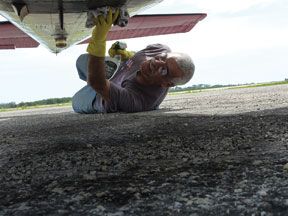The underside of an airplane is out of sight and thus usually out of mind until the owner peeks downstairs to check something. And there, in all its filthy resplendence, is a flying Super Fund site. How to clean it up? To find out, we recently tested a crate full of commercial cleaners designed if not specifically for this task, then for general degreasing and clean-up. Lasering right to the findings, all of them work, some are better than others, but the overarching consideration is to have a strategy to get this messy job done just frequently enough to keep the airplane clean without getting obsessive about it.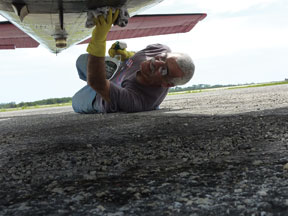
Why Do it?
The reasons for doing this go beyond the cosmetic. Greasy dirt can conceal things youd like to see, like loose fasteners, degrading paint or cracks. The larger issue is belly-mounted transponder and DME antennas, which don’t work well-and sometimes not at all-with a slathering of dirty oil. So, what are we looking for in a degreaser? Something that allows doing the job quickly, easily and without having to slide under the airplane with a creeper much, if at all. Preferably, the product should be just aggressive enough to get the filth off, but not so harsh as to soften the paint. (Some of these degreasers will do that.)
Where possible, we would prefer to avoid having to wear protective equipment for breathing, eyes and skin and, again, some of these cleaners require that. Generally, belly degreasing is going to happen outside, so ventilation isn’t an issue. In a hangar, however, it could be.
Cost is not much of a driver here, but ease of application is. If whatever method you use to degrease is more of a hassle than it needs to be, you wont do it as often as you should.
With these criteria in mind, we bought 16 commercial products from Aircraft Spruce, which constitutes most but not all of whats on the market. Conceding there are other products that might be as good or better, feel free to contact us with your own suggestions.
Cleaner Classes
There are two ways to sort these cleaners-by chemical makeup or by packaging. In the chart on page 10, we sorted the cleaners into three categories-aerosols, spray bottles and mixed solutions, since these relate directly to one of our primary criteria: ease of use.
First, the aerosols. We bought seven varieties of these ranging in price from $5.80 to $24.95. At the expensive end, are LPSs Super Degreaser and CRC Super Degreaser. In addition to being expensive, these aggressive chemical solvents showed signs of going after the paint and, to be fair, they are really not suited for this job. The same is true of LPSs HDX, a trichloroethylene-based solvent. Best to use these sparingly and with both eye and breathing protection. We would spray a bit on a rag and degrease that way, rather than spraying the
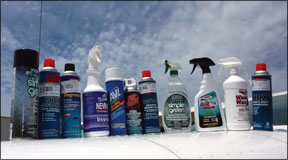
paint and removing the gunk and degreaser.
Two of the aerosols are naptha-based-AVL No Chlor and LPS Presolve. These arent as aggressive as the others and also not as effective. you’ll need a little elbow grease and lots of rags. Tri-Flow Citrus Foaming was in this group, too, although its propanol, not naptha. The foam nozzle worked poorly on this product, in our view, so we saw nothing to recommend it.
Another foaming product is Simple Green Foaming. Although we considered this the best pick of the aerosols because it is effective, its also messy. The foam quickly eats up the grease and plops down your arm like gooey lard. The material is polyethylene glycol and, compared to the others, is non-toxic. Its not specifically intended for aircraft.
Bottom line on the aerosols is that we don’t like them much. They tend to be more expensive, the sprays are harder to control and if you don’t stay to windward, you’ll get a face full. There are better solutions.
Spray Bottles
We found five of these, all under $11, making them generally better values. The most expensive of these, PPC Belly Wash, is supposedly a dedicated product consisting of surfactant enhanced detergents. Its non-toxic, but somewhat slimy to work with. The spray head didnt work as we’ll as Simple Greens did.
One of these products, Aero Cosmetics Wash Wax All, is designed to work with or without water and indeed it does. Spray it on, wipe it off and youre left with a clean, somewhat slick surface. But it will take quite a few rags to do a full belly and you’ll probably want a scrubbing rag and a removal rag.
Of this group, we liked Simple Green and Extreme Simple Green the best. We didnt notice that it was particularly more or less effective than the others, but the packaging was
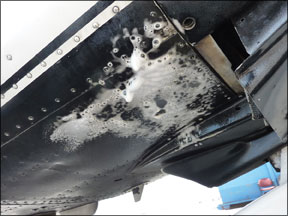
robust-important if you carry cleaners with you-and the bottle neck had a pistol shape, which nicely met our test for ease of application. At $10.65 , its closer to the top of the price tier than the bottom.
Note that Crystal Simple Green is not intended for aircraft use, but we think its fine for painted surfaces. If youre picky, get the Extreme Simple Green Precision Aircraft version.
Mixed Solutions
Which leads us to the mixed solutions meant for fleet wash applications, of which we tried three, plus Gunk SC Degreaser. And here lives the winning entry. Arrow-Magnolia makes a range of solution-type industrial detergents including the two we tried, Carbon X and Mach 1. These are sold in gallon jugs-or 55-gallon drums if you own an airline-and are mixed with water in up to a 20-to-1 ratio.
So the hot set-up here is carwash style. Mix up a bucket of suds and use a brush to scrub away the grime. Carbon X is supposed to be better for exhaust stains, but we thought both products were about equally effective. The key advantage is that with a long-handled brush, you can do most of the degreasing at a distance, without the creeper bath. These products were just effective enough to remove the grease, without being too harsh.
Another product we tried was Jetstreams Hydrasolve, a gel-type water soluble product also meant for mixing with water. It works about like the Arrow-Magnolia products, but cant be cut
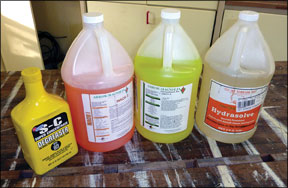
as much with water.
The Gunk SC is an aliphatic petroleum product intended for mixing with other solvents, such as Stoddards or naptha. Its overkill and a little impractical for belly work, but good for parts and engine cleaning.
Bottom Line
We picked the Arrow-Magnolia washes as the best overall choice because while youre degreasing, you can use the same stuff to wash the rest of the airplane. One job, one day…done.
But heres the thing: The brush wash will miss stuff, like areas around antennas or around skin laps. So that means you’ll need to go back and spot clean the leftover grime. For this, any of the spray bottle cleaners will be fine. Our first pick is Simple Green, but PPC Belly Wash or All Natural Never Dull are good performers, too.
If youre unhealthily obsessive about belly cleaning while traveling, we would go with Wash Wax All and some durable fiber towels that can be discarded after use. It does a good job without water, even if the applicator bottle leaves something to be desired. Finally, a word about composite aircraft. Diamond and Cirrus both say any cleaning product suitable for metal that doesnt attack the paint is acceptable for composite surfaces. Cirrus cautions against using cleaner containing silicone, which none of the products we tried do.

